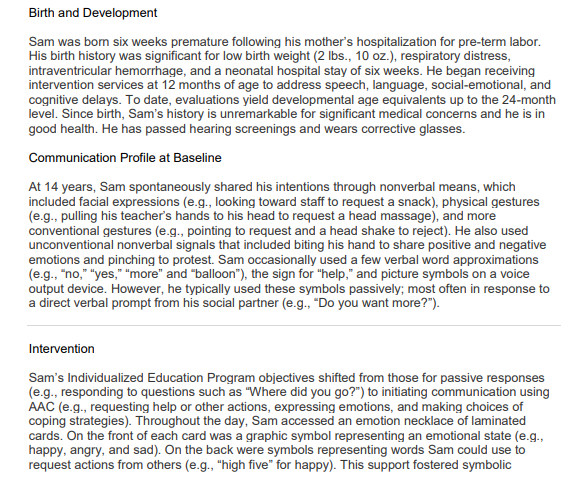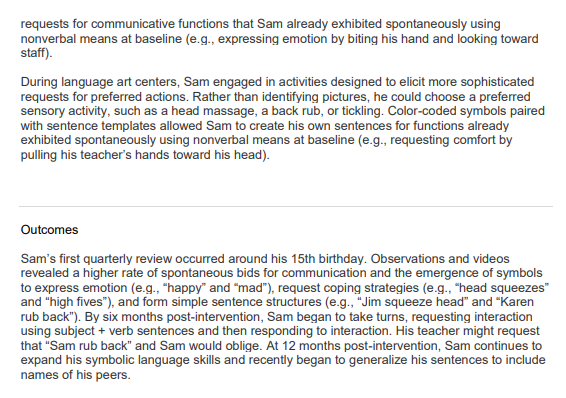Describe Autism Spectrum Disorder with a minimum of 300 words that includes: definition, epidemiology, signs and symptoms, treatment and management.
Describe Autism Spectrum Disorder with a minimum of 300 words that includes: definition, epidemiology, signs and symptoms, treatment and management.
Essentials Health Info Management Principles/Practices
4th Edition
ISBN:9780357191651
Author:Bowie
Publisher:Bowie
Chapter6: Patient Record Documentation Guidelines: Inpatient, Outpatient, And Physician Office
Section6.3: Hospital Inpatient Record— Clinical Data
Problem 13E
Related questions
Question
Admitting Diagnosis: Autism Spectrum Disorder
Sam is a 16-year-old young man with ASD and significant cognitive delays. Sam attends a
public school special day class that offers frequent instruction in varied settings to foster
independence in the community. (more details on the attached pics)
Question:
1. Describe Autism Spectrum Disorder with a minimum of 300 words that includes: definition, epidemiology, signs and symptoms, treatment and management.

Transcribed Image Text:Birth and Development
Sam was born six weeks premature following his mother's hospitalization for pre-term labor.
His birth history was significant for low birth weight (2 lbs., 10 oz.), respiratory distress,
intraventricular hemorrhage, and a neonatal hospital stay of six weeks. He began receiving
intervention services at 12 months of age to address speech, language, social-emotional, and
cognitive delays. To date, evaluations yield developmental age equivalents up to the 24-month
level. Since birth, Sam's history is unremarkable for significant medical concerns and he is in
good health. He has passed hearing screenings and wears corrective glasses.
Communication Profile at Baseline
At 14 years, Sam spontaneously shared his intentions through nonverbal means, which
included facial expressions (e.g., looking toward staff to request a snack), physical gestures
(e.g., pulling his teacher's hands to his head to request a head massage), and more
conventional gestures (e.g., pointing to request and a head shake to reject). He also used
unconventional nonverbal signals that included biting his hand to share positive and negative
emotions and pinching to protest. Sam occasionally used a few verbal word approximations
(e.g., "no," "yes," "more" and "balloon"), the sign for "help," and picture symbols on a voice
output device. However, he typically used these symbols passively; most often in response to
a direct verbal prompt from his social partner (e.g., "Do you want more?").
Intervention
Sam's Individualized Education Program objectives shifted from those for passive responses
(e.g., responding to questions such as "Where did you go?") to initiating communication using
AAC (e.g., requesting help or other actions, expressing emotions, and making choices of
coping strategies). Throughout the day, Sam accessed an emotion necklace of laminated
cards. On the front of each card was a graphic symbol representing an emotional state (e.g.,
happy, angry, and sad). On the back were symbols representing words Sam could use to
request actions from others (e.g., "high five" for happy). This support fostered symbolic

Transcribed Image Text:requests for communicative functions that Sam already exhibited spontaneously using
nonverbal means at baseline (e.g., expressing emotion by biting his hand and looking toward
staff).
During language art centers, Sam engaged in activities designed to elicit more sophisticated
requests for preferred actions. Rather than identifying pictures, he could choose a preferred
sensory activity, such as a head massage, a back rub, or tickling. Color-coded symbols paired
with sentence templates allowed Sam to create his own sentences for functions already
exhibited spontaneously using nonverbal means at baseline (e.g., requesting comfort by
pulling his teacher's hands toward his head).
Outcomes
Sam's first quarterly review occurred around his 15th birthday. Observations and videos
revealed a higher rate of spontaneous bids for communication and the emergence of symbols
to express emotion (e.g., "happy" and "mad"), request coping strategies (e.g., "head squeezes"
and "high fives"), and form simple sentence structures (e.g., "Jim squeeze head" and "Karen
rub back"). By six months post-intervention, Sam began to take turns, requesting interaction
using subject + verb sentences and then responding to interaction. His teacher might request
that "Sam rub back" and Sam would oblige. At 12 months post-intervention, Sam continues to
expand his symbolic language skills and recently began to generalize his sentences to include
names of his peers.
Expert Solution
This question has been solved!
Explore an expertly crafted, step-by-step solution for a thorough understanding of key concepts.
Step by step
Solved in 2 steps

Recommended textbooks for you

Essentials Health Info Management Principles/Prac…
Health & Nutrition
ISBN:
9780357191651
Author:
Bowie
Publisher:
Cengage

Health Safety And Nutrition F/Young Child
Health & Nutrition
ISBN:
9781305144767
Author:
MAROTZ
Publisher:
Cengage


Essentials Health Info Management Principles/Prac…
Health & Nutrition
ISBN:
9780357191651
Author:
Bowie
Publisher:
Cengage

Health Safety And Nutrition F/Young Child
Health & Nutrition
ISBN:
9781305144767
Author:
MAROTZ
Publisher:
Cengage
